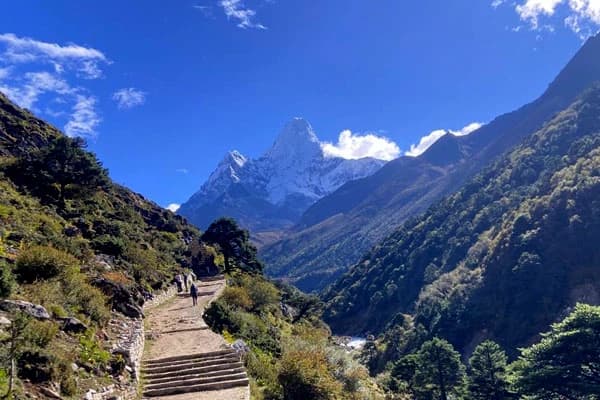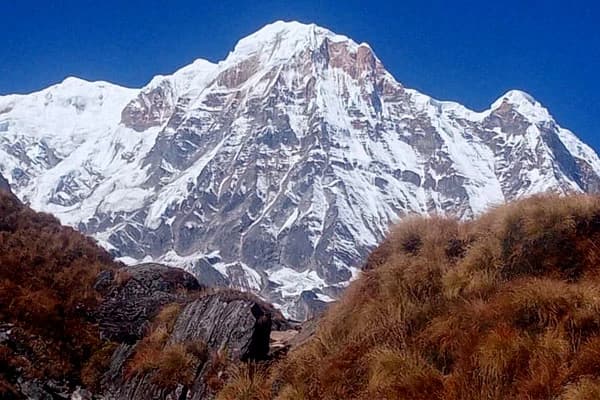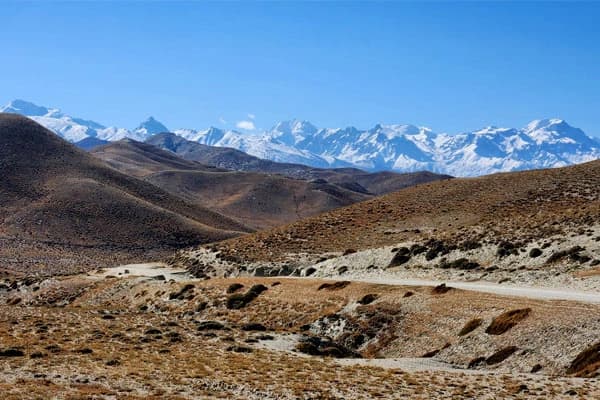How To Pick The Right Accommodation For The Trek?
Finding the right place to stay during a trek is not rocket science, but it does require some thought. In the beginning, ask yourself: Are you okay with basic rooms? You won’t find five-star hotels in the mountains, but you’ll be comforted at the end of your hike. Look for tea houses that have good reviews from other trekkers. Word of mouth is what matters up there! Clean bathrooms, hot meals, and courteous use do count. Some lodges will even have WiFi, but do not expect it to work perfectly at 4,000 meters, along the Annapurna Base Camp route.
Budget is also important; the higher you go, the more expensive it gets. It’s just the way things are on treks in places such as the Annapurna Circuit and Manaslu Circuit Trek. At Destination Himalaya Treks and Expedition, we always advise our clients to book with agencies that check lodge quality beforehand.
My honest advice? Don't be overly picky. Sometimes the simplest lodge and the warmest smile give you the best mountain experience. So ready for your adventure?
Types Of Accommodation during the Annapurna Base Camp Trekking
Accommodation during the trek to Mount Annapurna offers a big variety so that tourists can enjoy what they want and what they can afford. One can enjoy local culture, comfort, or an adventure; anything and everything is on offer here. From the humble teahouses to nice lodges, traditional homestays to camping, they all present a different way of experiencing the trek. Accommodation plays a major role in keeping your trek fun and relaxing. Now, let us discuss the main accommodation types you will encounter on the ABC route.
Teahouses With Basic Comfort
Want to feel like a true mountain explorer? Teahouses are just the option for you! These humble lodges have been accommodating trekkers since the 1950s. Consider teahouses your base away from base, only much simpler and cozier.
Most teahouses have two single beds, foam mattresses, blankets, and the necessary wooden furniture. You’ll use shared bathrooms with the other guests and it’s all a part of the experience. You could barely find another time when you talk to someone from Germany or Japan and brush your teeth at the same time. These dining halls are filled with stories from fellow adventurers.
Typically, a local family runs them, usually for generations. After a long walk, cool hot dal bhat will be served, which will taste like Heaven. Some of the teahouses now offer Wi-Fi as well, but at 4,000 meters altitude, don't have very high expectations of the connection! While hot showers and Wi-Fi might cost you extra, the environment and local hospitality make teahouses feel like a home away from home.
Lodges: More Comfort, Facilitated Amenities
Think of lodges as those elder siblings living in the comfortable realm of teahouses. Better rooms, cleaner facilities, and sometimes even attached bathrooms are basic luxuries of the mountains! Dining facilities are usually a step above the average, with improved heating and much better organized service. Some indeed have hot showers that cost no extra. Bathing in warm water after trudging through the snow sounds like heaven on earth! The rooms are still quite basic, with proper beds and clean sheets, maybe with the addition of a small table.
With a higher standard of cuisine also comes some Nepali traditional dishes-just a little better. Maybe more pasta, pancakes, and other international cuisine, a good alternative if you have been eating dal bhat every day. You'll find these upgraded lodges in prominent places like Ghandruk and Ghorepani in the Annapurna Region. They cost more than the basic ones, but they really are worth your money for the extra comfort. Choose according to your comfort and budget, for sometimes even that extra bit of comfort means a lot on your trekking journey!
Homestays: Cultural Immersion With Gurung Families
Want to live like a local in the Annapurna Sanctuary? Homestays with Gurung families are simply magical! They provide not just shelter but a window into the real mountain life in Nepal. You will stay with the families inside their very own houses and be part of their daily routine. Among the Gurung, you’ll find warm greetings, invitations to share food and tales and perhaps some new Nepali phrases you can learn. You could wake up to the smell of baking bread in your host’s home or enjoy cooking with your host mother, following generations-old ways of making their meals.
While the rooms are not fancy, they are clean, and you will find them in the home’s main building. You will have meals with the family, sleep on good beds, and use their bathrooms. What you won't find here are fancy comforts; what you will find are smiles, laughter, and energy flowing between seeds of genuine connection. The homestays dot the villages of Ghandruk and Chhomrong, where you're able to witness how actual folks live in the mountains, tend their farms, and uphold their culture in all its colorful magnificence. Similar experiences await you on other treks, such as the Langtang Valley Trek, as well.
Camping Option For Adventure Seekers
Feeling adventurous? Camping simply takes the trek to that next level! Instead of going to lodges, you will now be sleeping under the starry sky and a canvas sheet as a shield. There can't be another more unforgettable experience! Your camping crew installs everything for you like tents, sleeping bags, portable toilets, and a full kitchen. Your cook prepares fresh meals for you, and all you do is relax, gazing over the mountains. There will be no hurried scrambling for rooms or sharing toilets with strangers. It is like a mountain hotel entirely to yourselves!
Camping also pairs well when you are trekking in the peak season, when lodges everywhere are very full. In places that do not have any teahouses, you can pitch your tent and head out to relatively remote and pristine areas. The thought of watching the sunrise from your tent door with nobody about is just amazing! The downside? It is costlier because of the needed extra hands, equipment, and supplies.
If you want assistance with booking accommodation and the whole trek, agencies like Destination Himalaya Treks and Expedition can help guide you to the best options.
Accommodation availability on the ABC Trek
While trekking into Annapurna Base Camp, sleeping arrangements are offered in simple teahouse lodges. Consider them cozy family-style homes in which travelers get to enjoy an overnight stay. You will be given a simple room with two beds and thin blankets to keep you warm during the night. After all, bathroom facilities will be shared with another trekker, which is quite standard for most mountain trails. The higher you walk, the more basic the services will be. Hot shower? You may be asked to spend a couple of extra bucks! Places such as Ghorepani and Chhomrong might offer nicer accommodations, perhaps even with private bathrooms.
Once you reach Base Camp, enjoy simpler facilities until the end of your stay. Pairing up and bunking with some fellow climbers will surely make for some memories to recall later, complete with hilarious stories! The cost gets steeper as you ascend, just because it's a nightmare carrying supplies all the way up the mountain. Overall, accommodation on the ABC trail is modest but comfortable enough to rest and enjoy the stunning mountain views.
Pokhara/ Kathmandu: Before Your Trek
Setting out for an Annapurna region adventure takes a long preparation, even on the mountain trails! Pokhara and Kathmandu are the two cities where you can do some preparations and rest for the trek ahead. Kathmandu is where one finds all kinds of accommodations from budget hostels to expensive hotels. This bustling capital rented you an hour to shop for last-minute trekking gear, meet your guide, and maybe visit some temples for good luck! The city can assault you with its noise of streets, but this is very much an aspect of the Nepal experience.
Generally, Pokhara is more laid-back and much nearer to the mountains. You can even somehow catch a glimpse of the Annapurnas directly from your hotel! The lakeside area fares well for that dinner before the day of your trek, and a quick round of final preparations. Most trekkers opt to stay here simply because of the cool ambiance. There are tons of hotels, restaurants, and shops in either city. Make sure you check your trekking permits and meet your guide or group before proceeding to the trail. You need to have a great night's sleep here so that you'll kick off the trek fresh and energized.
Tikhedhunga Village/ Hile: First Night Stay Option
After driving from Pokhara, would you feel like making either Tikhedhunga or Hile your first stop? The relaxed atmosphere in villages provides a refreshing change after life in the city. At this spot, you will appreciate the serene and green environment which includes quiet hills, forests and sounds from nature. The simple lodges and teahouses here are all about your first mountain night. They are super nice and welcoming and will make you feel so much at home. Want to discuss with others about the trekking thoughts for tomorrow? The dining areas provide the best opportunities to make friends over hot meals.
Here is the smart part: by staying in these villages, your body slowly adapts to mountain life. No rush, no stress, just good food, comfortable beds, and time to prepare for the thrilling days ahead. Think of this as a soft introduction to Himalayan adventures!
Ulleri: Starting Point Of The Trek
Here's where your big mountain adventure begins! Ulleri is the base from which the famous stone steps start, hundreds and hundreds of them drift straight up. Sound scary? Don't worry; every step goes deeper into the beautiful mountains. A small yet lively village, Ulleri is full of teahouses and lodging where trekkers like to stop and rest their weary feet. The forests around Ulleri and the incredible hill views will take your breath away! And after all those steps, that simple dal bhat will taste amazing!
The best part is that Ulleri builds your strength for what comes next in the adventure. It's like your training ground for the mountain. Every trekker that passes through will feel a sense of achievement, now you're really in the trek! Local people here are keen on cheering you on. Ulleri is challenging but very rewarding and welcoming to all trekkers. Similar to other full-on climbs on the Three Passes Trek, this is where you're going to prove to yourself you can manage the mountains.
Ghorepani: Rich Cultural Experience
This is one of the most well-known stops during your entire hike! Ghorepani is not just a random village for trekkers, traders, and mountain culture; it is rather an incredible cultural mix that is the hotspot during the Ghorepanii Poon Hill Trek before ascending Poon Hill. The name implies "horse water" because traders would stop here to water their horses. Isn't that a pretty cool history? It is an active village with some of the best lodging experiences throughout the trek to ABC. The tea houses are well established, many with attached baths, and a remarkable variety of food. From Nepali traditional food to pizzas and pancakes, they basically have it all in 2,850 meters!
And magic truly occurs at night. The lodge dining rooms come alive with trekkers exchanging tales, guides singing traditional songs, and making plans on when to climb up for sunrise views of Poon Hill. Pretty much a mountain party every night! Cultural exchange is beyond incredible as you'll meet travelers from dozens of countries all sitting together around a wood stove. The sunrise from Poon Hill is legendary, and most trekkers wake up at 4 a.m. to catch it. The mountain views are totally worth missing some sleep!
Tadapani: Best View Of Rhododendron And Acclimatization
Be prepared to see the world in all its colorful glory! Tadapani attracts people with its impressive rhododendron forests, all bursting with reds, pinks and whites in the spring. Imagine walking in a mountain natural garden; it is amazing in its beauty! This village is located at 2,630 meters, an ideal site for acclimatization. Your body needs some time to adjust to thinner air, and Tadapani is right for that. The lodges here are simple and cozy with warm dining rooms where you may relax and enjoy hot meals.
Mountain vistas from Tadapani are breathtaking. You have Annapurna South, Hiunchuli, and many other impressive peaks to gaze upon during fine weather. A majority of the trekkers spend an extra day in Tadapani just exploring the rhododendron trails and capturing stellar pictures. Teahouses are few here, meaning that it’s a good idea to reserve your spot in advance during the busiest time. Local residents run the lodges and they take great joy in sharing their warmth. We frequently encourage our clients to choose Tadapani as the perfect place for enjoying views and adapting to the high altitude.
Deurali Village: Tips For Avalanche Risk
Welcome to one serious section of your trek! Deurali sits at a high level where the weather may change quickly with serious risks of avalanches. But in fact, you don't need to worry if you know how to account for and take precautions. The village has the most basic lodges with simple rooms and shared bathrooms. Food is rather limited, so don't expect fancy meals. Nonetheless, the lodge owners have a lot of experience with the region and understand the dangers of the weather.
You should never go on a hike by yourself in the area, always follow your guide’s guidance on the weather and be prepared to stop if the conditions are unsafe. Snow can make some of the trails dangerous, and winds are usually strong. Due to the weather, lodges around here tend to get packed. So just go with the flow and try to stay flexible. Local guides can very well tell you when it's OK to proceed and when it's best to wait. At Destination Himalaya Treks and Expedition, we always stress safety-first when it comes to Deurali.
Annapurna Base Camp: Basic Rooms With Stunning Views
Congratulations! There you are at 4,130 meters, the famous Annapurna Base Camp. The teahouses are very basic, but honestly, who cares outside a setting that is filled with some of the world's most beautiful mountains?
The rooms are simply made of stone, with thin walls that could not protect you from the cold, basic beds, and a shared bathroom. It becomes freezing cold at night, so carry along a warm sleeping bag. You will hear conversations from neighboring rooms, but that is just another experience at the base camp! What makes it so special? The mountain views all around are spectacular. You are literally amidst the giants of Annapurna I, Annapurna South, Hiunchuli, and Machapuchare. Sunrise and sunset here will give you chills--good ones!
The lodges offer very basic meals, mostly dal bhat and noodles. Hot drinks are extra, but they are well worth the price at this altitude. There is internet, but don't expect it to be working fine. Similar basic conditions prevail at other base camps like Mardi Himal Base Camp, too. Are you ready to sleep with the giants?
Jhinu Danda: A Simple Yet Popular Spot For Hot Springs
Time to relax those tired muscles! With natural hot springs that feel like heaven after days of trekking, Jhinu Danda is a celebrated attraction. In this village, several simple lodges offer common rooms and shared bathrooms. A few lodges even have attached bathrooms to boast about, a major luxury for camps in higher altitudes. The food is OK, with some Nepalese and a few international dishes on offer.
But the hot springs steal the show completely! Getting to the hot springs downhill from the main village will take about 20 minutes. Using these hot water pools, with natural jets, relaxes your aching legs and reduces some muscle pain. Here, many trekkers would spend hours chatting away with fellow travelers as their feet enjoy the warm waters. There are a lot of greens here, with many trees and bird songs amidst the mountain views. From around the springs, local families have erected fairly basic facilities, but they are very accommodating towards visitors. The glories of the spring season can be well imagined here.
Pothana Village: Ending Point
What a perfect way to end your amazing trek! Pothana is situated at an elevation of 1,990 meters and is blessed with views of mountains that remind you of all you have done in the journey there. The trail will fill you with pride when you look at those towering peaks.
That village has decent lodges with better facilities than you have had in days. Some even have attached bathrooms, hot showers, and working WiFi! After minimal mountain accommodation, these comforts practically feel like luxury hotels. There are plenty of wild animals and gorgeous forests around Pothana. You might come across colorful birds, butterflies or various other animals. The varied local people here love to meet trekkers and listen to their adventures. From Pothana, a pleasant walk takes you to the road where you can find transport back to Pokhara.
Budget for Accommodation and Price Guide
Let's talk money. How much does it cost for accommodation on the trip to Annapurna? The good thing is that accommodation on the ABC trek is quite affordable, but prices do go up as you get higher. In the lower villages like Tikhedhunga and Ulleri, prices for a basic room run around USD 3-5 per night. These are twin-sharing rooms with shared bathrooms. Not bad, while on a mountain adventure! In Ghorepani and Tadapani, the prices of accommodation increase as one goes higher, about USD 5-8 per night.
At this point, you should know that the cost gets higher as you increase your altitude. Staying in rooms at Machhapuchhre Base Camp and Annapurna Base Camp will typically cost you USD 8 to 12 per night. What causes the jump? Well, the entire equipment has to be carried up by porters or yaks, making everything expensive. Want an attached bathroom? Add USD 2-5 extra per night, but it is only available in some lodges. Hot shower costs extra too, usually USD 2-3 every time. During the peak seasons of October-November and March-May, prices can easily be doubled so plan accordingly! All in all, you should take about USD 150-200 in total for accommodation.
Essential Amenities
Accommodation while trekking in the Annapurna Base Camp has a few basic facilities to make your stay comfortable. Though much simpler than their city counterparts, many teahouses and lodges will give you the option of a hot shower, electricity, Wi-Fi, and laundry, usually paid for separately. Here is a brief description of what you can expect from these very important services:
Hot Shower
Hot shower facility is offered in many teahouses, especially the ones at lower and mid-altitude stops. Hot water is typically produced manually using a wood stove or gas, so one usually pays extra for having an indulgence of a hot shower (around USD 5 to 7). At higher altitudes, the availability of hot water could be scarce or sometimes even non-existent. After a long trekking day, nothing can beat a warm shower.
Wi-Fi
A few teahouses and lodges provide Wi-Fi, mostly in the bigger villages. At lower altitudes, the Wi-Fi may be free or made available for inclusion by means of room rent, but as you go higher, it is usually USD 3 to 5 an hour or per recharge card. It is often so slow and sometimes so unreliable. Plan to stay online using Wi-Fi only in bigger villages or better lodging.
Electricity
Electricity is found in many teahouses and lodges, which sometimes charge a fee of USD 2- 5 while charging your devices. Power is mostly solar-powered or through generators, so in cases of extreme weather, the power may be disrupted. Bring a power bank, which you will definitely thank yourself for.
Laundry
Some teahouses and lodges around the lower and mid-altitude stops provide laundry service. You could hand over your clothes to the staff to be washed and dried for a small charge. Generally, the higher you go, the rarer laundry facilities become, according to the cold and dry weather conditions, so it is always best to pack quick-drying clothes and wash small items yourself if need be.
Safety And Altitude Considerations For Lodging
It's super important that you keep safe in mountain lodges, even more so at high altitudes. Altitude sickness is the biggest worry: if one climbs too fast without giving the body enough time to adjust, it can set in.
Most of the lodges above 3,000 metres do have some form of heating, but the rooms can get pretty cold at night. Be sure to carry a warm sleeping bag rated for at least -10°C. Hence, altitude sickness is a real threat if you go in unprepared. If you begin to feel sick at altitude, the lodge owners can offer you advice on how to handle the problem. Headache, feeling nauseated and being dizzy are the usual symptoms. Please be sure not to miss these. When you feel really unwell, move to a lower altitude as soon as possible.
Basic first aid is offered at all the lodges, though major emergencies require rescue in a very remote area. Therefore, you should choose experienced guides who are available through agencies such as Destination Himalaya Treks and Expedition. We know which lodges are safest and how to deal with altitude emergencies.
Booking Tips For Peak Season And Avoiding Crowds
- Book your ABC Trek ahead of the peak trekking season. Usually it is 2-3 months before peak seasons come, i.e., October-November or March-May. Popular lodges tend to fill up very quickly, especially those in Ghorepani and Annapurna Base Camp.
- In December and September, you will face fewer crowds and pay less. So, it's still a good time weather-wise while nearly half as costly compared to peak months. Also, you won't be scrambling for bathrooms and dining tables.
- Usually, more trekkers start on weekends, resulting in overcrowding on the way. But you should start it on Tuesday or Wednesday. There will be more rooms available, plus you will experience some peace in the mountains.
- You must research 2 to 3 different lodges in each village. If the first option is full, then alternatives can be presented. Your guide should have multiple lodge options for every stop along the trail.
- Good agencies like our own know the lodge owners and can obtain rooms for their clients even during peak times, so choose a topnotch trekking agency like us. We know which lodges have space and make advance bookings.
- If the main ABC trail is blocked, consider alternate routes like going through Jhinu Danda first or the Ghandruk route. These alternatives are equally beautiful and are generally less crowded than the routine trail.
- Avoiding large groups can make your trek more peaceful and enjoyable. Smaller groups move faster and find accommodation more easily along the trail.
(In the end, you can rely on Destination Himalaya Treks and Expedition to make sure your accommodation during the trek is handled so that you never miss a good place to rest.)
Conclusion
Walking to Annapurna Base Camp is a once-in-a-lifetime, spectacular mountain-view adventure amidst esoteric culture and cozy yet basic accommodation. According to planning, you may choose to stay anywhere-from simple teahouses to lodges, or home stays to camping in the open air. So, in a way, the trek is not only about reaching the base camp but equally about developing inner love for the beauty of nature and the warm hospitality of locals while passing in between.




